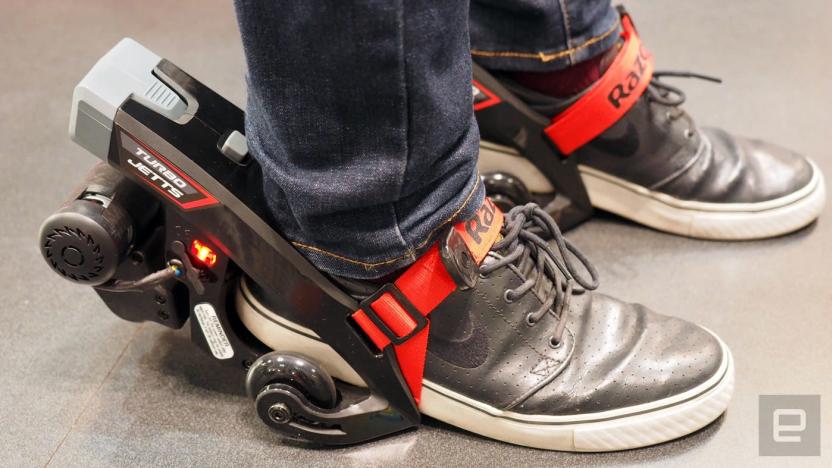skates
Latest

Razor's e-skates are equal parts Heelys and hoverboard
As a cranky, childless adult in her late thirties I've largely missed the boat on personal transportation trends like Razor scooters, Heelys and hoverboards. This year Razor manages to combine all of those things into its new Turbo Jetts e-skates: It's the sort of thing that your inner child will love, even as your adult self screams, "Get off my lawn!"

RocketSkates let you zip along the sidewalk at a top speed of 12MPH
Let's nip your enthusiasm right in the bud: No, these motorized skates you see above aren't actually powered by rockets. Now hold on, don't close the browser tab just yet. Just launched on Kickstarter, Acton's RocketSkates do have a rather misleading name. But they're actually quite the improvement over the Spnkix, the company's previous effort at a pair of motorized skates (which, incidentally, unceremoniously crashed our podcast stage during CES 2013). Unlike the Spnkix, the RocketSkates are about six pounds lighter, have four hub motors instead of two, are 15 percent smaller and can zoom up to 12 miles per hour. Oh, and most notably, the RocketSkates don't require a remote to operate. That's right; just like regular skates, these motorized puppies can let you zip around the sidewalk completely hands-free.

Spnkix motorized skates crash the final Engadget CES podcast (video)
Right in the middle of our final CES podcast, we were mildly interrupted by a man on battery-powered heels. These are Spnkix, a pair of wheel-toting heels that can be lashed to your shoes (Men sizes 6-14, Women sizes 7-15.5). You can expect to push out around 7 miles of coverage on a single charge -- depending on your weight and angle of the surface. Charging takes around 4 to 5 hours, while the battery units are removable if you reckon you'll be making an extended journey. Speeds top out at 10mph, while a wireless controller (that also takes removable batteries) allows you to manipulate the speed, while a stopper on the heel will be familiar to anyone who's roller-skated before. Spnkix Pro, seen here, will set you back $699 and they're available to buy at the source below.

Therma Blade heated ice skates landing soon
A product some five years in the making is nearly set to hit the ice, and it's (quite literally) bringing the heat along with it. The Therma Blade, invented by Canada's own Tory Weber, is a battery-warmed ice skate that purportedly melts the ice just beneath the skater to provide the wearer with "more speed, less work and an overall better hockey experience." Currently, it seems uncertain whether the new blades will ever see action in the NHL, but amateurs could certainly get an edge over their opponents if they're willing to pay the premium. Unfortunately, we've no idea how lofty that premium will be, but according to the official website, there's under a fortnight left till we find out.[Via TheStar, thanks Corey]

Angle grinder + rollerblades = hazardous transportation
While we've noticed a few DIY creations that fell in the "don't try this anywhere" category, the Go-llerblades just may take the cake. Without getting into too much detail (seriously, you'll want to view this one from a distance), strapping a modified angle grinder onto a rollerblade whilst carrying a backpack battery system enables a mettlesome individual to burn some serious rubber (or polyurethane) with next to no actual effort. Staying in control, however, becomes extremely challenging. We'd typically recommend hitting the links below (and catching the video after the jump) in order to give this a whirl yourself, but this time we'd visit strictly for the laughs. [Via Wired]Read - Go-llerblade creation, part IRead - Go-llerblade creation, part II



